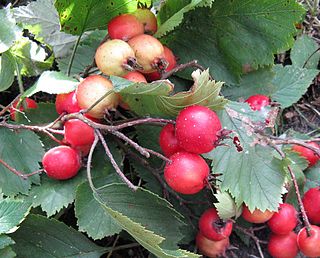
Crataegus aestivalis, known as the eastern mayhaw, is a shrub or small tree of the southeastern United States that grows in low-lying or wet areas from eastern Alabama to central Florida and Virginia. It is one of several species of hawthorn with fruits known as "mayhaws", which are harvested for use in making mayhaw jelly, considered a delicacy in many areas of the South. Other species of mayhaws include Crataegus opaca, the western May Hawthorn, which is native from east Texas to Alabama.
Crataegus aemula, the Rome hawthorn, is a species of hawthorn that is common in some parts of Mississippi and Georgia, and also occurs in Alabama. It is a perennial shrub or tree. Its habitats include oak flatwoods and brush.
Crataegus fluviatilis is a species of hawthorn similar to C. flabellata and to C. macrosperma. The name C. apiomorpha has been applied to a form of the species that is most similar to C. macrosperma.
Crataegus populnea is a hawthorn native to the northeastern U.S. and southeastern Canada. The flowers have about 10 stamens with red to purple anthers, and the fruit are orange to red, about 1 cm in diameter, spherical or oblong. Crataegus compta is a variant with pear-shaped fruit.

Crataegus crus-galli is a species of hawthorn known by the common names cockspur hawthorn and cockspur thorn. It is native to eastern North America from Ontario to Texas to Florida, and it is widely used in horticulture. It is thought to be the parent, along with Crataegus succulenta, of the tetraploid species Crataegus persimilis.
Crataegus ellwangeriana is a named hawthorn species that has been poorly understood and often misidentified. It is now considered to be a synonym of C. coccinea var. coccinea. A study concluded, that C. pennsylvanica of series Molles has frequently been misidentified as C. ellwangeriana.

Crataegus flabellata is a species of hawthorn known by the common name fanleaf hawthorn. It is native to the northeastern United States and adjacent Canada. It is intermediate in appearance between C. macrosperma and C. chrysocarpa. C. macrosperma, which occurs throughout the range of C. flabellata and also in the southeastern U.S., is often misidentified as C. flabellata.

Crataegus marshallii is a species of hawthorn known by the common name parsley hawthorn. It is native to the southeastern United States.
Crataegus putnamiana is a rare species of North American hawthorn derived from hybridization between a species in Crataegus series Coccineae and a species in series Dilatatae.

Crataegus submollis, known as the northern downy hawthorn, northern red haw, Quebec hawthorn, or hairy cockspurthorn, is a species of hawthorn that grows to about 7 m in height and typically carries large crops of red fruit.

Crataegus wattiana, the Altai hawthorn, is an Asian species of hawthorn. The original description states that it has yellow fruit with five stones (pyrenes). Crataegus wattiana var. wattiana has become naturalized in Seattle, in the U.S. state of Washington.
Crataegus iracunda, with common name passionate hawthorn, and sometimes called the stolon-bearing hawthorn is a North American species of hawthorn. It was described in 1899 by Chauncey Delos Beadle of the Biltmore Herbarium in North Carolina. Taxonomic opinions have differed about this species, and to complicate matters Crataegus macrosperma and various species of C. series Populneae have frequently been misidentified as C. iracunda, leading to differing statements about its geographic range. The 2015 Flora of North America considers its range to be in the southeastern U.S., restricted to the US states of Alabama, Georgia, Louisiana, Mississippi, North Carolina, South Carolina, and Virginia.
Crataegus visenda is a species of hawthorn from the southeastern United States, in Alabama, Florida, and Georgia. It is a large shrub or small tree to 10 m tall. It has been considered as a synonym of Crataegus flava Aiton
Crataegus rufula, or Crataegus × rufula, known as the rusty hawthorn or rufous mayhaw, is a shrub or small tree of the south eastern United States. It is one of several species of hawthorn with fruits known as "mayhaws", which are harvested for use in making mayhaw jelly. It is thought to be a hybrid between the other two species of mayhaw.

Crataegus pennsylvanica, known as the Pennsylvania thorn, is a species of hawthorn native to Delaware, New York, North Carolina, Ontario, Ohio, and Pennsylvania, that grows to about 8 m in height. The mature trees have few thorns.

Series Molles is a series within the genus Crataegus that contains at least six species of hawthorn trees and shrubs, native to Eastern North America. Some of the species are cultivated as ornamental plants. They have relatively large leaves, large flowers, and bloom early for hawthorns. The plant parts are usually hairy, particularly in early growth, and the fruit are generally red and are large for hawthorn fruit.
Series Populneae is a series within the genus Crataegus that contains at least eight species of hawthorn trees and shrubs, native to Eastern North America. Only one species, C. populnea is widespread.

Section Coccineae is a section within the genus Crataegus that includes the majority of North American hawthorn diversity. It includes at least 20 series as well as some species that have not yet been assigned to series.
Series Pruinosae is a series within the genus Crataegus that contains at least six species of hawthorn trees and shrubs, native to Eastern North America. They are similar in some respects to series Intricatae. They are very thorny, with medium to large leaves, and hard fruit that are usually pinkish in colour.

Series Tenuifoliae is a series within the genus Crataegus that contains at least seven species of hawthorn trees and shrubs, native to Eastern North America, with one disjunct species in the mountains of New Mexico.







